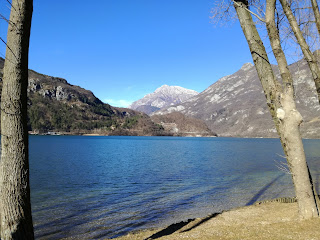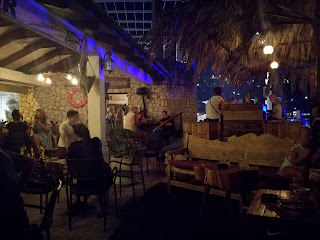Ako vam, kad pomislite
na Italiju, padaju na pamet samo stereotipi, mogli biste se iznenaditi.
Neke od mojih predodžbi
o Italiji bile su:
Vrijeme u Italiji
uvijek je toplo i sunčano, Talijani su svi preplanuli, glasni i opušteni,
pomalo neuredni; svi talijanski gradovi izgledaju kao Rim (iz filmova) ili kao
negdje na Siciliji; spaghetti i pizza su posvuda, kao i elegantno i po
zadnjoj modi odjeveni ljudi...
Nakon što sam nekoliko
puta posjetila sjevernu Italiju moja se slika promijenila.
Sjeverna Italija je
najviše industrijaliziran, najrazvijeniji i najproduktivniji dio te zemlje.
To je, naravno,
utjecalo na životni stil koji je vrlo različit od onoga što sam gore napisala.
I ne samo to. Njezin zemljopisni položaj još je jedan važan faktor.
Dat ću vam primjer
najsjevernije talijanske pokrajine imena Friuli-Venezia
Giulia. Ona graniči s Austrijom na sjeveru, a Slovenijom na istoku.
Zahvaljujući tim granicama, pejzaž koji prevladava su planine, jezera,
brežuljci i šume.
(Lago di Cavazzo)
(Lago di Cavazzo)
Klima je također raznolika, ali uglavnom umjerena.
Velike količine kiše
zaslužne su za prekrasne zelene boje
tamošnje vegetacije.
(Torrente torre)
(Roštilj na rijeci - Torrente torre)
Što
se tiče lokalnog govora, govori se talijanski s dosta njemačkog i slovenskog
utjecaja. Dijalekt kojim se služe lokalci u ovoj regiji zove se „friulano“ – i ponekad ga je teško
povezati s književnim talijanskim. Za one od vas koji govore talijanski, evo
nekoliko primjera friulano dijalekta:
cjan = pas
gjat = mačka
fradi = brat
libri = knjiga
U svakom slučaju, ovdje nećete čuti poznati stereotipni usklik „Mamma mia!“. (Također, korištenje ruku u gestikulaciji je puno manje uobičajeno nego što biste očekivali od Talijana).
cjan = pas
gjat = mačka
fradi = brat
libri = knjiga
U svakom slučaju, ovdje nećete čuti poznati stereotipni usklik „Mamma mia!“. (Također, korištenje ruku u gestikulaciji je puno manje uobičajeno nego što biste očekivali od Talijana).
Glavni
grad ove pokrajine je Trst (grad koji je u suprotnosti s tipičnim
karakteristikama ove regije obzirom da se nalazi na obali). Ako želite
pročitati više o Trstu i pogledati slike, otvorite moj tekst o Trstu
na sljedećem linku: http://meninaidris.blogspot.hr/2016/05/
(Trieste)
Sjeverni
Talijani ili Friulani (iz ove regije)
izrazito su marljivi ljudi, a vrste zabave slične su onima kod njihovih susjeda
– lokalni festivali (sagra) vrlo su
uobičajeni i popularni. Tamo ćete pronaći brojne vrste piva i lokalnu hranu,
naravno.
Lokalna
hrana također se razlikuje od talijanskih stereotipa
(iako je pizza i dalje vrlo popularna i može se
naći u svakom
restoranu).
Spomenut ću dva tipična friulani jela koja sam pronašla
posvuda: frico i polenta. Frico se radi od prženog ili pečenog
sira i krumpira. Polenta je skuhana
kukuruzna kaša koja se
nakon toga peče na roštilju ili zapeče u pećnici.
(Frico - može se kupiti kao suvenir, ali najbolji je svježe pripremljen)
Još jedna tipična stvar za sjevernu Italiju je
izrazito dobra
iskorištenost prostora, tako da nema prostranih polja koja
ostaju neobrađena. Slično je s gradovima. Svaka
pokrajina ima svoj glavni grad
(u ovom slučaju Trst), ali
mnoštvo gradića je u njegovoj blizini. Svakih
nekoliko
kilometara jedan je mali grad sa svojim središnjim trgom, crkvom,
lokalnim trgovinama i restoranima / barovima.
Kuće i stanovi ljudi su obično
oko tog centra. Ti centri malih gradova dojmili su me se kao tipično talijanski
u svojoj arhitekturi te kao vrlo ugodna mjesta za posjetiti.
(Cividale)
(Tarcento)
(Tarcento)
(Tarcento)
(Tarcento)
Nedjeljom ćete na trgovima vidjeti obitelji i
prijatelje koji
uživaju uz piće, kolač ili cijeli obrok u jednom od restorana s
ukusnom hranom i izvrsnom kavom.
(Tarcento)
Sve slike vlasništvo su bloga @menina idris - connected









































































